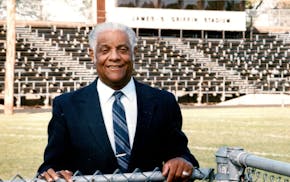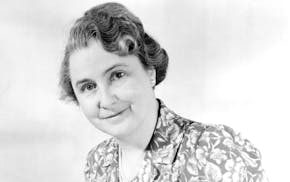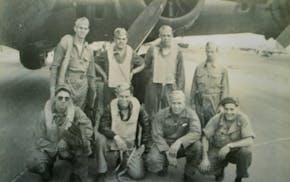Walter Ball, the son of a St. Paul barber, was listed as a railroad porter in the 1900 federal census. Ten years later, a census taker's cursive script spelled out a higher calling for Ball, referring to his industry as ball player and his occupation, pitcher.
And not just any right-handed hurler, but among the best Black pitchers in the early 1900s, according to James Riley's "Biographical Encyclopedia of the Negro Baseball Leagues." Many baseball experts say Ball might have made it to the major leagues if not for the color line dividing the best players of the era.
Ball "was a smart pitcher with good control, and made frequent use of the spitball, but was not a power pitcher," Riley wrote. "Off the field, the premier hurler was noted for his sartorial splendor, wearing tailored suits and earning a reputation as the 'swellest' dresser."
Despite Ball's personal style and dazzling stats — including leading a St. Cloud semi-pro team to a 1902 championship and winning 23 consecutive games with the St. Louis Giants in 1912 — he's been forgotten by all but the most ardent baseball historians, more than 500 of whom will gather Aug. 7-11 at the Hyatt Regency Minneapolis for the 52nd annual national convention of the Society for American Baseball Research (SABR).
Along with panel discussions featuring local Hall of Famers Rod Carew, Bert Blyleven, Tony Oliva and Jim Kaat, the SABR convention will feature some deep-in-the-weeds baseball history talks — including an Aug. 10 presentation on "Black Baseball in Minnesota." Walter Ball's career will be discussed, including his role organizing and managing the St. Paul Colored Gophers in 1907.
The historical record surrounding Ball is loaded with discrepancies, starting with his birth; most sources say he was born in 1877 in Detroit. By age 8 he was living in St. Paul, according to his SABR profile by Terry Bohn (https://tinyurl.com/WalterBall). "In his teens, Ball began playing on the sandlots of St. Paul," wrote Bohn, a Bismarck, N.D., hospital administrator.
Soon Ball was pitching for the Young Cyclones, a top St. Paul amateur team, before launching his vagabond career. "Characteristic of many of the early players in Black baseball," according to Bohn, "Ball spent the next several years jumping between numerous teams."
He played for more than a dozen teams, including ones in Osceola, Wis., Devils Lake, N.D., Grand Forks, N.D., Chicago, Brooklyn, N.Y., and Minneapolis. To augment his meager baseball earnings, he worked as a sleeping car porter.
Ball was headed to Duluth in 1902, but the team disbanded when local ministers rallied against Sunday games. When his old Grand Forks team rejected him after it moved to a new league that toed the color line, Ball played instead in St. Cloud from 1902 to 1904, according to Ball's file at the Stearns County History Museum.
That file includes sports page clippings describing his spring 1902 games against the Globe Trotters, an all-star team with players from the Twin Cities, Duluth and Red Wing. He won the first game to improve his record to 4-0, saved a victory in the next game and then threw a complete-game loss, according to author and SABR researcher Stew Thornley.
The late Jim Karn, a baseball historian from Crookston, Minn., chronicled all of Ball's 1902 games in St. Cloud. Ball went 17-7 and allowed only 61 runs in 207 innings en route to the state title. He also played third base and centerfield, batting .307 with one home run and 29 runs scored in 37 games played.
"Ball rarely played with other black teammates from the beginning of his career in 1890 through the end of the 1902 season," Karn wrote. "Conversely, from 1903 when he moved to Chicago until the end of his baseball career in the 1920s, Ball played and coached exclusively on all-Black baseball teams."
Ball was in his 40s when the Negro National League was formed in 1920. A few years later, he organized his own traveling team, the "Walter Balls," and hired a young promoter named Abe Saperstein to schedule his team's games. Saperstein would go on to launch and coach the Harlem Globetrotters basketball team.
Records show that Ball married a St. Paul woman named Cora Ray in Grand Forks in 1900. Their first child, Wendell, died while still a toddler. Though ancestry.com lists only one marriage, the SABR profile says he might have remarried three times and fathered four more children. But Ball's records are inexact at best, and he's often confused with another pitcher named George (Georgia Rabbit) Washington. Subsequent research on a baseball blog clarifies the discrepancies (https://tinyurl.com/WalterBallResearch).
Away from the diamond, Ball joined a Chicago-based comedy and musical troupe with hopes of a vaudeville career that never seemed to blossom. He worked his final years as a janitor and recreation director.
Ball died in Chicago on Dec. 16, 1946, after a lingering illness, at the age of 69. Earlier that year, Jackie Robinson had enjoyed a stellar minor-league season with the Montreal Royals. He broke major league baseball's color line four months after Ball's death.
For more information on SABR's convention, including membership and single-day admission, go to the local chapter's website, http://www.halseyhall.org/, and follow the links.
Curt Brown's tales about Minnesota's history appear every other Sunday. Readers can send him ideas and suggestions at mnhistory@startribune.com. His latest book looks at 1918 Minnesota, when flu, war and fires converged: strib.mn/MN1918.

Minnesota History: Ad man turned Paul Bunyan into a folklore icon

Minnesota History: James Griffin used persistence to blaze a trail for St. Paul's Black police officers

Minnesota History: For Granite Falls doctor who tested thousands of kids for TB, new recognition is long overdue

Minnesota History: A New Ulm baker wearing a blanket fell to friendly fire in the U.S.-Dakota War




